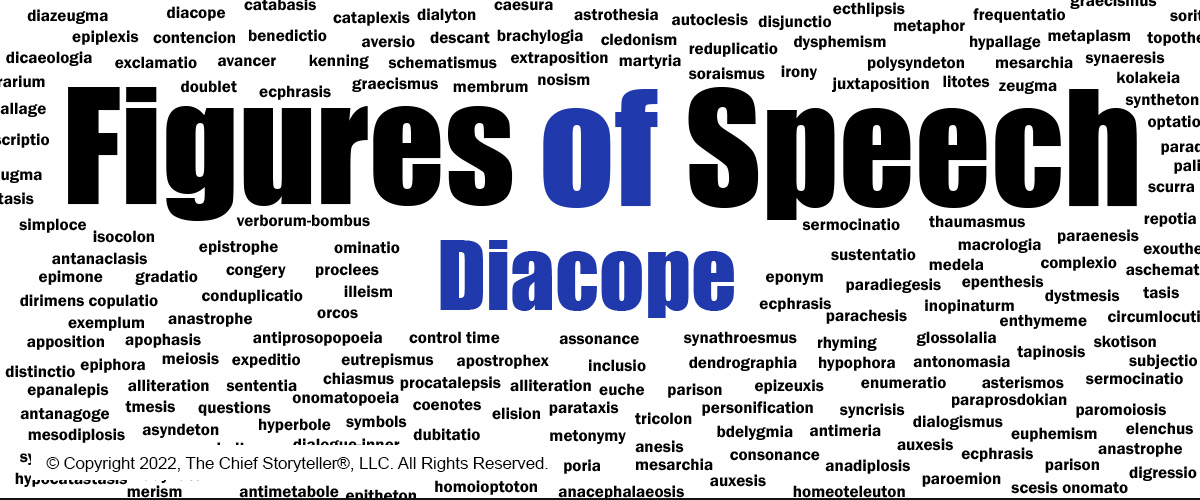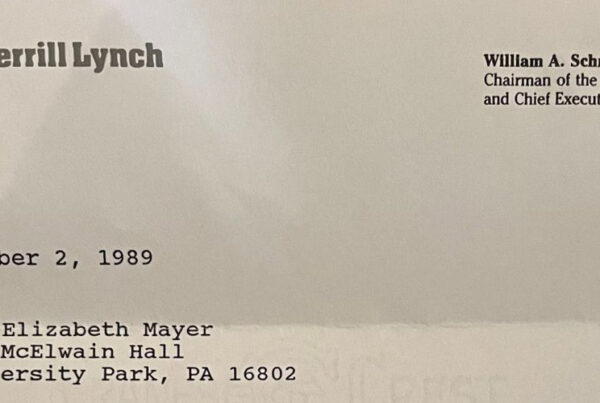
This blog post is about Diacope, a Repetition Figure of Speech. It is part of a series on repetition. I share them as the English language has hundreds of literary devices to help you (dramatically) improve the effectiveness and impact of your various communications.
Repetition used well, strengthens your written and spoken narrative with emphasis and emotion. Repetition is by far, one of the most powerful of all figures of speech. Why? Because as human beings, we are programmed to recognize patterns and to pay attention to them.
With all of my years of research and seeing and reading figures of repetition in practice, Diacope is absolutely, the most powerful strategic figure of repetition. Think of SEO for both search engines and for people. Deliberate repetition improves impact and memorability. Search engines reward you for proper keyword density. People reward you with sales, promotions, recognition, etc. for memorable stories and communication.
And one of the best uses of Diacope is with your Better Tomorrow Message™. Typically, in a three-minute story, I recommend stating your Better Tomorrow Message™ two or three times. With a one-hour presentation, I recommend five to seven times. With long-form blog posts and articles, say 2,000 words, I recommend, five to seven times.
Whatever your goal, what is most important is the application of each figure of speech in your written, spoken, and social media communication.
When I do my consulting, workshops, training, and teach my class on public speaking and storytelling (I’m an adjunct professor at The Robert H. Smith School of Business at the University of Maryland), I tell them all…
“You never have to remember the actual Greek word for the figure of speech.
You DO have to remember the concept and proper use of it.”
Emphasis & Impact Figures of Speech include Anadiplosis, Anaphora, Asyndeton, Diacope, Epanalepsis, Epiphora, and Polysyndeton.
Amplification Figures of Speech include Auxesis and Epizeuxis,
Figures of Sound include Onomatopoeia.
Other Figures of Speech include Procatalepsis and Portmanteau.
There are three major sections:
- Figure of Speech. Includes a little background, usage, definition, pronunciation, other related figures of speech, and etymology.
- Usage Guidelines. Follow these guidelines to ensure maximum impact.
- Examples of Diacope. Find examples from speeches, presentations, presidential addresses, poems, music, and more
1) DIACOPE – FIGURE OF EMPHASIS & IMPACT
Diacope is a figure of repetition where a word or phrase is repeated deliberately after any number of intervening words, including multiple times in longer communications such as with multi-thousand-page books. The key is, deliberate and obvious repetition.
| Definition | Diacope is a figure of repetition where a word or phrase is repeated deliberately after any number of intervening words |
| Pronunciation | dee – AK – o – pee |
| Also Known as | semi-reduplication |
| Related to | Anaphora, Epanalepsis, Epiphora |
| Etymology | Derived from the ancient Greek word, διακοπή (“gash, cleft, rupture”). From διά (diá, “through, across”) + κοπή (kopḗ, “cutting”) |
2) USAGE GUIDELINES
Here is my own definition of Repetition.
Repetition is a literary device where a word or phrase is repeated two or more times to emphasize the point being made and/or emphasize the emotional feeling associated with the point being made. With more than 30 forms of repetition, it is more commonly thought of as a category rather than thought of as a single figure of speech.
Here are some guidelines for you to ensure Diacope, your figure of repetition, achieves your communication goals:
| Use Deliberately | The strength of Diacope as a strategic figure of repetition, is to use it deliberately with your key messages, especially your Better Tomorrow Message™. As with every figure of repetition, use it sparingly. |
| Choose a Simple Word or Phrase | If you were to analyze narratives where Diacope is used, you would find the authors use simple words and simple phrases. You want to ensure your audience is able to readily remember your ideas. Simple always wins the day. See below for examples. |
| Repeat 3 Times or More |
Since humans look for and respond to patterns, I recommend using three of the “repetition type” you are using and for Diacope, consider using it more if your communication is lengthy. Deliberate repetition ensures your readers and listeners know with certainty you are using the repetition to make a point or to increase the emotional feeling of your narrative. |
| Emphasize with Your Voice | In my training and teaching, I share specifics on how to use one’s voice to add (dramatic) impact to your spoken communication. Think of yourself as an orchestra with three main instruments: Your Words, your Body Language, and your Voice. Varying your tone of voice, cadence, and speed are what separates a great speaker from a good speaker. |
3) EXAMPLES OF DIACOPE
Look at the examples below. See how Diacope is used to dramatically increase the effectiveness and impact of your words. Then experiment, mixing and combining other figures of speech in your written, spoken, and social media communication.
Example 1: Never Give In, Never, Never, Never, 1941 – Winston Churchill
| Without Notation | In October of 1941, as England was fighting for its life against Germany during World War II, the English Prime Minister, Winston Churchill, delivered a speech meant to galvanize the English people so that they wouldn’t give up in the face of German power. The following lines were part of Churchill’s speech:
“Never give in — never, never, never, never, in nothing great or small, large or petty, never give in except to convictions of honour and good sense. Never yield to force; never yield to the apparently overwhelming might of the enemy.” |
| With Notation |
This example is a bit complex, employing four different figures of repetition.
“Never give in — never, never, never, never, in nothing great or small, large or petty, never give in except to convictions of honour and good sense. Never yield to force; never yield to the apparently overwhelming might of the enemy.” The deliberate repetition of “Never” is diacope. Note 1: { Never give in } is repeated twice. This is an example of anaphora. |
Example 2: Romeo and Juliet, 1597 – William Shakespeare
| Without Notation | “Romeo, Romeo, wherefore art thou Romeo?” |
| With Notation |
“Romeo, Romeo, wherefore art thou Romeo?” |
Example 3: Harvard Business Review, 2020 – Lisa Zigarmi
| Without Notation | “Lisa Zigarmi is an organizational psychologist and leadership coach. She helps leaders relate more deeply, decide more efficiently, and think with more creativity. She is the founder of The Consciousness Project“ |
| With Notation |
This is from Lisa’s author bio.
“Lisa Zigarmi is an organizational psychologist and leadership coach. She helps leaders relate more deeply, decide more efficiently, and think with more creativity. She is the founder of The Consciousness Project” Note 1: { deeply } and { decide } is an example of alliteration. |
Example 4: Together for Better, 2022 – Umpqua Bank Website
| Without Notation | Umpqua believes that we can build economic vitality together. We do that by putting our priority on people and the communities they live in. That’s true if Umpqua is your personal bank, business bank, or private bank.
We are the largest bank headquartered in the Pacific Northwest, with nearly $30 billion in assets and more than 200 locations in Idaho, Washington, Oregon, California, and Nevada. In addition to retail banking, Umpqua also offers comprehensive business banking and commercial finance services. We are a bank but think of us as your financial partner. Because Umpqua knows that the best way forward is together. Together for people. Together for business. Together for better. |
| With Notation |
Umpqua believes that we can build economic vitality together. We do that by putting our priority on people and the communities they live in. That’s true if Umpqua is your personal bank, business bank, or private bank.
We are the largest bank headquartered in the Pacific Northwest, with nearly $30 billion in assets and more than 200 locations in Idaho, Washington, Oregon, California, and Nevada. In addition to retail banking, Umpqua also offers comprehensive business banking and commercial finance services. We are a bank but think of us as your financial partner. Because Umpqua knows that the best way forward is together. Together for people. Together for business. Together for better. Note 1: { Bank, Banking } repeated multiple times is an example of Diacope. |
Example 5: Carnegie Mellon University, Language Technologies Institute, 2021
| Without Notation | Get the right information to the right people at the right time in the right language, the right format and the right level of detail. |
| With Notation |
Get the right information to the right people at the right time in the right language, the right format and right level of detail. |
References: I use a combination of my experience, my personal library of books and journals, sources from the Internet, and my 710-plus page Story Elements Resource Guide. My favorite sources include, in alphabetical order: American Rhetoric, Encyclopedia Britannica, LitCharts, Literary Devices, Merriam-Webster Dictionary, Oxford English Dictionary, Silva Rhetoricae, and ThoughtCo. My favorite books include: A Handbook of Rhetorical Devices by Robert A. Harris; Elements of Eloquence by Mark Forsyth; and A Handlist of Rhetorical Terms, 2nd Edition by Richard A. Lanham.
Photography Source: Message Cloud/Word Cloud designed by The Chief Storyteller®, LLC. © Copyright 2022, All Rights Reserved.
#chiefstoryteller #communication #figuresofspeech #language #rhetoric



